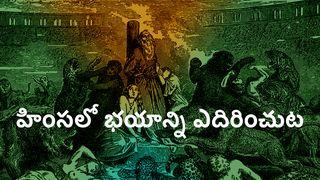Introduction To The Study Of The Tabernacleనమూనా

THE TABERNACLE WAS A TYPE OF CHRIST
We read in Hebrews 8:5 and 9:9: who serve the copy and shadow of the heavenly things . . It was symbolic for the present time... The word copy means ‘type’ or ‘shadow’. So, we are reminded that the tabernacle was only a shadow of something bigger that lies in the future (Heb. 9:11-14). The tabernacle in the wilderness was therefore an image and a shadow of Him (Christ) who would come.
The furniture of the tabernacle was arranged so that it formed the shape of a cross. The tabernacle therefore speaks predominately of one thing; our salvation in the work of the person Jesus Christ on the cross of Calvary. A close view of the arrangement of the furniture in the tabernacle shows an astounding truth, the whole tabernacle bears the stamp of the cross. The foot of the cross is the place of suffering and death - the altar of burnt offerings. The head or top of the cross is behind the veil in the Holy of Holies, the place of glory - the Shekinah of a completed work. From the outside to the inside it is a straight path of salvation, cleansing, intercession (prayer) and a torn veil (Heb. 10:20-22), right into the presence of God the Father. To the right and left of the two arms of the cross are two areas of blessings – fellowship at the table (shewbread), and the witness, the light - the golden candlestick. The tabernacle is God's witness to the cross of Calvary.
Without the tabernacle and its furnishings and the spiritual meaning contained therein and portrayed, we would never fully understand the doctrine’s of: salvation; reconciliation; substitution; atonement; righteousness; imputed righteousness; prayer; sanctification; forgiveness and mercy.
ఈ ప్రణాళిక గురించి

The tabernacle and all that goes with it speaks to us of Christ (Heb. 10:20). Jesus Christ came and dwelt among us. The Old Testament is the lock, the New Testament is the key; what is the use of a lock without a key? Knowledge of the Old Testament is necessary to fully understand the New Testament. Learn more about the tabernacle and the accompanying rituals in this series.
More
సంబంధిత ప్లాన్లు

నన్ను ఆజ్ఞాపించు – జీరో కాన్ఫరెన్స్

దేవుని కవచం - అపొస్తలుల చర్యలు

యేసు, అన్ని నామములకు పైన నామము

అద్భుతాల 30 రోజులు

30 రోజుల్లో కీర్తన గ్రంధం
క్రిస్మస్ హృదయంలో ఉంది - 7 రోజుల వీడియో ప్లాన్

ఈస్టర్ అనేది క్రాస్ - 8 రోజుల వీడియో ప్రణాళిక

ఈస్టర్ అనేది క్రాస్ - 4 రోజుల వీడియో ప్రణాళిక
